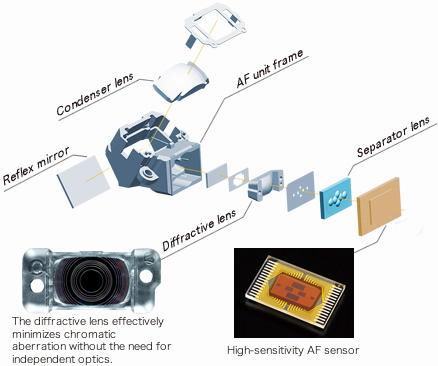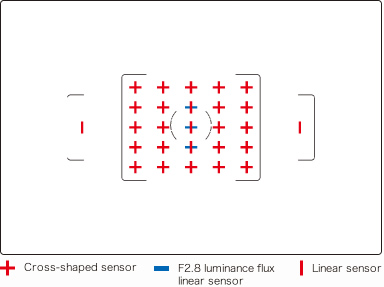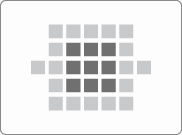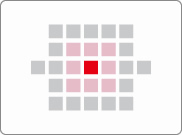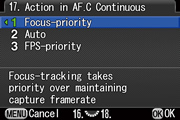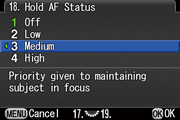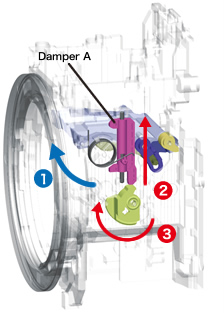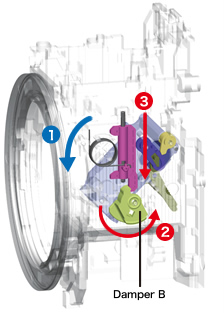
Today’s most advanced, standard-setting AF system, perfect for action photography
State-of-the-art SAFOX 11
to assure high-speed, high-precision autofocusing
The K-3 features the latest SAFOX 11 AF module equipped with a highly responsive, sensitive AF sensor. It also incorporates a diffractive lens in its optics to greatly improve focusing accuracy while effectively minimizing any chromatic aberration generated within the module. Since the entire module is encased in an airtight, shock-resistant housing, demanding outdoor shooting has very little effect on the K-3’s autofocusing accuracy. In addition, this module features a light-source sensor to eliminate minute focusing errors caused by certain artificial light sources.
27-point AF system with 25 cross-shaped sensors
to capture the subject in sharp focus, regardless of image composition
The K-3 features a 27-point AF system, with 25 cross-shaped sensors positioned in the middle, to assure accurate focus on the subject, and also to allow more flexibility in image composition. This system not only assures extra-accurate autofocusing when using a very fast lens with a large maximum aperture, but also very accurately detects hard-to-focus subjects in low-light situations.
High-precision AF with F2.8 luminance flux linear sensors
The center sensor and two sensors just above and below it are designed to detect the luminance flux of an F2.8 lens for high-precision autofocusing. When using a very fast lens with a shallow depth of field, these sensors greatly improve the focusing accuracy.
Dependable AF at super-low minimum luminance of –3 EV
The K-3’s high-sensitivity AF sensor assures dependable autofocus operation down to a minimum luminance of –3 EV (when using 25 middle sensors), preventing the AF mechanism from slowing down or being confused by high-contrast areas in back-lit situations. It also captures low-contrast subjects with great accuracy.

AF point select
to choose the best AF pattern for a subject or composition
The K-3 not only allows you to select the number of AF points for a given image composition, but also lets you shift their position in the image field. In addition to three basic modes (27-Point Auto” to use all AF points; “Select” to choose just one specific point; and “Spot” to narrow down the select area), you can choose more flexible zone select and select-area expansion modes to accommodate specialized applications.
Zone select
You can choose a set of nine points forming a square, which can be shifted as desired. The PENTAX Real-time Scene Analysis System detects a subject placed within this square, optimizes the focus, and tracks its movement — all automatically.
Select-area expansion*
Choose one of 27 AF points to focus on the subject, and the K-3 automatically tracks the subject and refocuses on it with the help of the neighboring points, even when it moves away from the initial point. You can select the desired expansion area from S (eight points), M (24 points) and L (26 points).
* This mode is not available in the AF.S (single) focus mode.
Auto tracking**
to trace the subject’s movement in tandem with the new scene analysis system
The PENTAX Real-time Scene Analysis System accurately detects the color, shape and movement of a subject, and keeps monitoring it throughout the imaging process. With the help of this innovative system, the K-3 automatically shifts the AF point to trace the subject’s movement with great speed and precision. Thanks to a wide AF area covered by 27 AF points, it maintains the sharp focus on the subject, even when it’s moving at high speed or when you are using the high-speed continuous shooting mode.
** This function is available when the camera’s AF mode is set to AF.C (continuous) or AF.A (auto).
AF customization
to fine-tune AF operation to individual preferences
Every photographer has his or her own preferred AF settings for specific subjects, photographic conditions and subject-tracking maneuvers. The K-3 accommodates these preferences with its extensive list of AF customization menus.
AF operation setting
You can assign the desired AF functions to the selected AF (AF.S or AF.C) and drive modes. In addition to the focus-priority and release-priority modes, you can also choose the FPS-priority mode during continuous shooting.
AF hold setting
Even when the subject moves away from the in-focus point or the K-3 loses the sight of the subject because of some obstacle, the K-3 retains the in-focus status. Depending on the photographic conditions or your preference, you can choose one of three holding durations.
AF hold off
This default setting enables the K-3 to respond more swiftly to a fast-moving subject since the AF system stays more sensitive to the subject’s movement. It also allows a speedier shift of the AF point when the subject moves away from the in-focus point or reappears from behind an obstacle.
AF hold high
Since the K-3 retains the in-focus status for a long duration, a fast-moving subject can be captured in sharp focus even when it moves behind some obstacles. This prevents the K-3 from shifting the AF point prematurely to an unintended point.
Explore the unknown world captured by high-speed shooting
High-speed continuous shooting at 8.3 images per second
to preserve the action in a sequence of images
Thanks to the PENTAX-exclusive three-motor and mirror-bounce damper mechanisms and the high-performance imaging engine, the K-3 provides high-speed continuous shooting at a maximum speed of approximately 8.3 images per second. With the K-3, you a much better chance of capturing “a once-in-a-lifetime image,” because you may find a better-composed or better-focused image which you might have otherwise missed with a slower drive speed.
Three-motor mechanism
for independent control of the mirror, shutter and diaphragm
The innovative three-motor mechanism, in which each motor optimizes the action of the shutter, mirror and diaphragm independently, is the key to the K-3’s high-speed continuous shooting. You can adjust the drive speed in three steps to match the speed of the subject’s movement.
Mirror-bounce damper mechanism
to stabilize the subject’s image and improve AE/AF precision
The newly designed damper mechanism minimizes the shock caused by the swing action of the mirror, at both the mirror-up and mirror-down positions. At either position, this mechanism instantly stabilizes the mirror to improve the precision and stability of the AE and AF systems.
At the mirror-up position
The arm of Damper A catches the mirror (1), then absorbs the shock by spring action (2). At the same time, Damper B rotates to regulate the action of Damper A and prevent swing-back action of the mirror (3).
At mirror-down position
The arm of Damper B catches the mirror (1), then absorbs the shock by spring action (2). At the same time, Damper A shifts downwards to regulate the action of Damper B and prevent swing-back action of the mirror (3).
60-image continuous shooting,
supported by high-speed data transfer and large-capacity buffer memory
Although the CMOS image sensor with 24 effective megapixels outputs large-volume data, the K-3 assures high-speed continuous shooting at approximately 8.3 images per second, and up to 60 images in JPEG format* (or 23 in RAW format) in a single sequence. You can keep releasing the shutter until you’ve achieved your photo goal.
* When shooting images in JPEG format (16M recorded pixels; BEST image quality), in AF.C H drive mode, at ISO 100, using an SDXC memory card.
Continuous shooting capacity
| Approx. 8.3 images per second |
JPEG (16M, BEST); AF.C H 60 images (23 in RAW)** |
| Approx. 4.5 images per second |
JPEG (16M, BEST); AF.C M 100 images (32 in RAW)** |
| Approx. 3.0 images per second |
JPEG (16M, BEST); AF.C L 200 images (52 in RAW)** |
** The number of images that can be captured in continuous shooting at ISO 100.
